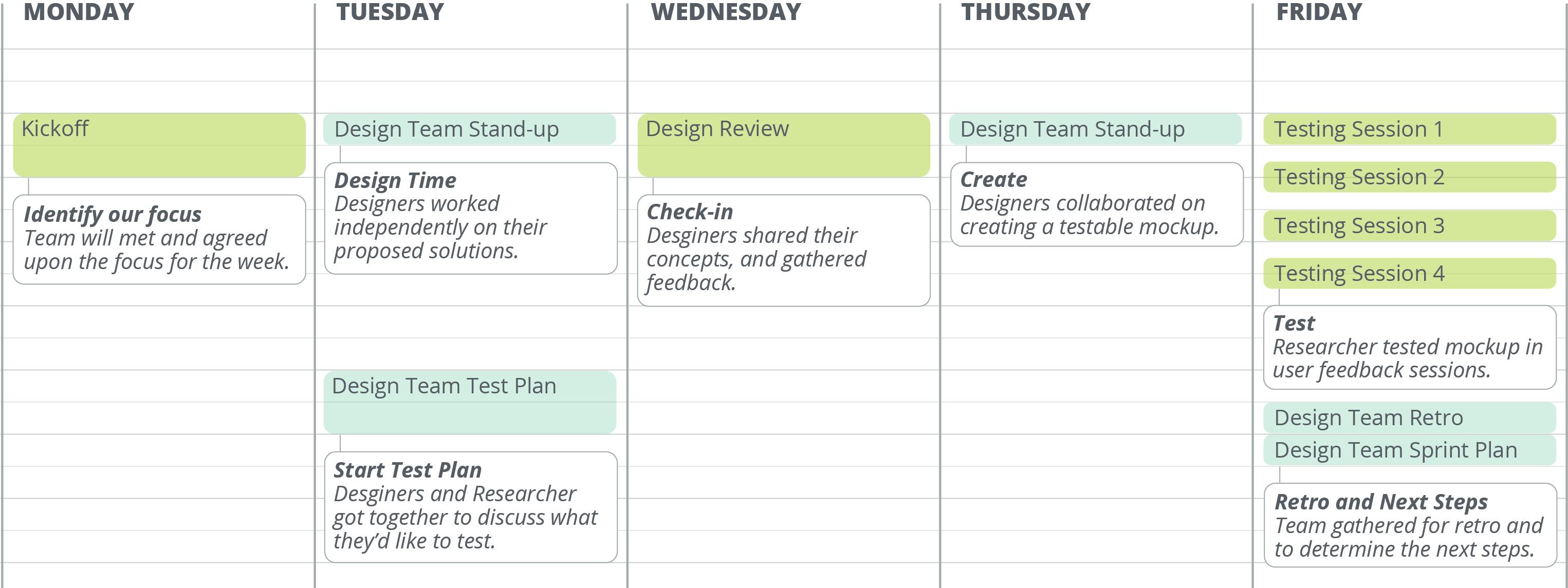Design Sprints
A Design Sprint is a time-boxed process for answering critical experience questions through design, prototyping, and testing ideas with users.
- Related Capabilities
We use the Design Sprint framework when we have a design problem to solve. The approach allows us to bring together subject-matter experts, skillsets, and disciplines to collaboratively and efficiently work through the design challenge.
Process
When is a Design Sprint the right approach?
- When we need information from others to solve the problem
- When the problem can't easily be defined
- When group buy-in is important (especially with business stakeholders)
- When we need to ensure focus and efficiency
Stages
The Design Sprint is a five-stage process that allows the group to quickly and efficiently work through a design challenge. The group will begin by defining the problem, and end with testing their decisions. These stages can take place within a few hours, or a few weeks. It should be determined by the team how much time is appropriate for their particular challenge.

- Identify - Team will meet and agree upon the focus for the week. Clarify any questions that arise.
- Design - Designers will work independently on their proposed solutions.
- Check-in - Team will share their concepts, and gather feedback.
- Create - Designers and researchers will collaborate on creating an artifact for testing.
- Representative Users - Researcher will test prototype with users, and gather feedback.
Participants
Consider these roles to make a design sprint successful:
- Facilitator - Guides conversations, and ensures everyone understands the process, their role, and what is expected of them.
- Decider - Helps the team move forward by making key decisions on direction if needed.
- UI Designer(s) - Drives the design process, creating sketches, mockups and prototypes to convey their vision.
- UX Researcher - Drive test plan conversations and facilitate any testing that will be needed.
- Tech Expert - Helps the group understand what is possible from an architecture/technology standpoint.
- Subject Matter Experts - Provides intimate knowledge of relevant systems and processes
- Representative Users - Helps validate design direction
Mindsets
Diverge & Converge
- We all work individually, but towards the same goal. Most of the activities during a sprint is individual, then we come together to critique and vote for the most viable option. People are encouraged to perform deep work in a Design Sprint. Focus, over discussions, allows team members to concentrate and think.
Just Go
- Getting started is more important than being right . Prioritize doing something over discussing the right way to do it. Then continually test the direction we took, and question it. We’ll find out very quickly whether or not it's working. Trust that the process will get us to the right place.
Show Me
- Visuals are more important than discussions . It is very helpful to have a visual or example to explain our thinking, vs just describing it. This helps cut through any ambiguity or miscommunication that might happen.
Just Ask
- We have a carefully curated group of SMEs, use them. The sprint team is brought together because each member has valuable knowledge that's needed to solve the problem. When you need an answer, don't wait, reach out and ask.
Vote & Decide
- Every voice is heard, the Decider decides so we move forward. It is essential that the Decider is the one who understand the problem in depth and have the vision to help find the right solution. Voting gives the Decider inputs to process their decision.
Timebox Everything
- Efficiency is paramount during a sprint. We are asking for a lot of people's time, so we must use it wisely. The amount of time you give yourself to do something, is the amount of time it will take.
Test
- Low risk, high reward. Getting work in progress in front of end users will help guide the design decisions being made.
Examples
Enrollment processing (CICS-to-UI) modernization was a complex undertaking that lacked a strategic vision. The Design Sprint process was implemented to kickstart the effort. Designers immersed themselves in the existing process, absorbing critical SME knowledge, and ultimately re-imagined and tested a new modern experience.
Sprint Preparation
- Held a pre-kickoff meeting with larger team to introduce the concept of a design sprint.
- Educated the team on how to how to participate, and what's expected of them.
- Began recruiting discussions for design sprint team and test users.
- Set up communication channels (Teams)
- Scheduled ceremonies
Identify the Team
We selected team members that would be visionaries, but that also had intimate knowledge of existing systems and processes.
Sprint Kickoff
- Did a round of introductions, and confirmed key roles for design sprint.
- Recap of the design sprint process, and highlighted key ceremonies that were scheduled.
- Ensured member availability at key moments throughout the sprint.
- Discussed and agreed upon the focus and goal for the sprint.
Sprint Focus & Goal
Focus for the Sprint
What the team agreed will be the focus at the beginning of the sprint.
- Design - Overall layout and experience
- Research - Borrower Data
Sprint Goal
What the team would like to have accomplished by the end of the sprint.
- Design - Mid-fidelity wireframe showing overall layout of the main screen, applicable to a forbearance processing task.
- Research - Near-complete understanding of the data needed to determine eligibility. Documentation of the data. Walk-through feedback sessions with our users.
Five-day Sprint

Let's Chat!
Together, we can understand and assist with the challenge or opportunity on your mind.
Connect